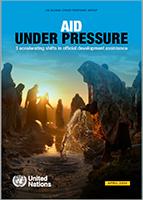
Official Development Assistance (ODA) is more than just cash. It is a powerful way to make a difference where it matters most.
It is aimed at improving economic development and welfare for millions of people. ODA, also referred to as aid, means having access to electricity and medical care, having food on the table, or even having an opportunity for a better future.
Global ODA reached record levels in 2022, $287 billion at constant 2021 prices, but continues to fall short of the SDG 17 aid target.
ODA from DAC donors remained $143 billion below the SDG 17 aid target of 0.7% of their gross national income. Moreover the aid landscape is undergoing shifts that may be detrimental to the development aspiration of some countries.
ODA is one of the most stable and predictable sources of external financing for developing countries, especially in times of crises.
Along with remittances and foreign direct investment, ODA represents a major source of external financing. While ODA is the smallest of these three sources in developing countries overall, for vulnerable countries, it often represents the main source of external financing.
Notably, ODA increased during the COVID-19 pandemic when other external flows declined.
Yet international crises leave visible marks on the ODA landscape, generating new demands and reshuffling priorities.
At a time when slowing economic growth, rising inflation and other macroeconomic challenges put pressure on aid budgets, dealing with new emergencies is inevitably complex. Even more so when crises directly affect donor countries.
In 2022, ODA for developed countries increased by $28 billion and for asylum seekers and refugees in donor countries it increased by $20 billion, driving the overall increase of ODA.
Aid flows to developing regions fell by $4 billion despite global ODA reaching record levels in 2022.
ODA for developing countries decreased by 2%. It fell by more than 3.5% for Africa, Asia and Oceania and least developed countries (LDCs) between 2021 and 2022. The decline in ODA affected the majority of developing countries, including 24 LDCs and 15 Small Island Developing States (SIDS).
ODA is increasingly provided through concessional loans, rather than grants, increasing developing country debt burdens.
Between 2021 and 2022, ODA grants to developing regions decreased by 8% to $109 billion, while loans increased by 11% to $61 billion, implying lower levels of concessionality of development assistance.
The share of grants in total ODA declined significantly. Over the decade 2012-2021, ODA grants represented on average 68% of the total. In 2022, their share dropped to 63%. This is the smallest share in two decades, with the exception of the first year of the COVID-19 pandemic (62%).


